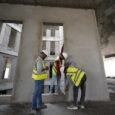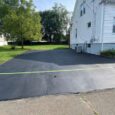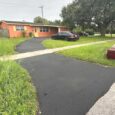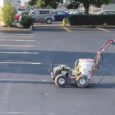The process for parking lot striping involves several steps to ensure accurate and durable markings. This article will outline the general process for parking lot striping, including preparation, layout design, equipment and materials, striping application, and maintenance.
How to Plan and Execute a Parking Lot Striping Project
Parking lot striping is the process of applying thermoplastic or paint to mark the boundaries of parking lanes, spaces, and other features on a paved surface.
1. Preparation
Before beginning the striping process, proper preparation of the parking lot surface is essential. This involves thoroughly cleaning the surface to remove any dirt, debris, oil stains, or other contaminants that may affect the adhesion of the striping paint. Pressure washing or sweeping the surface is typically done to ensure a clean and smooth surface for the striping application.
2. Layout Design
Once the surface is prepared, the next step is to design the layout of the parking lot. This includes determining the number and size of parking spaces, accessible parking spaces for individuals with disabilities, directional arrows, crosswalks, and any other required markings. This is an important step to ensure efficient traffic flow, maximize parking capacity, and comply with local regulations and ADA requirements.
3. Equipment and Materials:
To perform the striping, specialized equipment, and high-quality materials are needed. Striping machines are commonly used to apply the paint evenly and accurately. These machines can be operated manually or driven, depending on the size and complexity of the parking lot. The paint used for striping is typically a high-quality traffic paint that is durable, quick-drying, and resistant to fading, cracking, and peeling.
4. Striping Application:
With the layout design finalized and the equipment and materials ready, the striping application process begins. The striping machine is loaded with the paint, and the operator carefully follows the pre-determined layout, using the machine to create straight lines, accurate measurements, and proper spacing between markings. This process requires precision and attention to detail to ensure clear and visible lines.
During the striping application, it is important to consider safety measures. Temporary traffic control measures, such as cones or barricades, may be used to redirect traffic or secure the area being striped. It is also crucial to ensure the safety of pedestrians by using caution signs and providing clear pathways.
5. Drying and Curing:
After the striping is completed, the paint needs time to dry and cure before the parking lot can be reopened to traffic. The drying time can vary depending on the temperature and humidity conditions. It is important to follow the manufacturer’s instructions for the specific paint being used to ensure proper drying and curing.
6. Maintenance and Repainting:
Over time, parking lot striping may fade or become worn out due to regular use, weather conditions, and general wear and tear. Regular maintenance and repainting are necessary to maintain clear and visible markings. This may involve periodic re-striping or touch-ups to ensure the longevity and effectiveness of the striping. Regular inspections should be conducted to identify any areas that require maintenance or repainting.
In conclusion, the process for parking lot striping in Dallas involves thorough preparation of the surface, careful layout design, the use of specialized equipment and high-quality materials, precise striping application, and regular maintenance. By following these steps, parking lot owners and managers can ensure safe and efficient traffic flow, maximize parking capacity, and comply with ADA regulations. Professional striping contractors can provide expertise and experience in executing the striping process to achieve optimal results.




